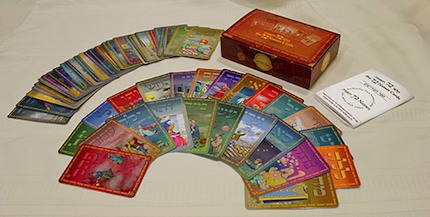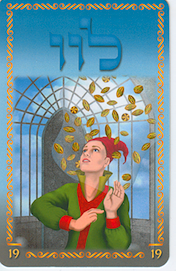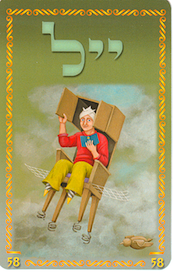By Sheri Harshberger
The 72 Names Cards by Orna Ben-Shoshan
Self-published, http://kabbalah.ben-shoshan.com
The 72 Names Cards is an oracle deck created and published by Israeli artist Orna Ben-Shoshan that is based on the 72 Names of God, which aren't *really* names but Kabbalah-based, sacred combinations of Hebrew letters that can be used for soul work and guidance. If you have seen the recently released King Solomon Oracle Cards from U.S. Games Systems, Inc., or the artist's Wheel of Wisdom, you may already recognize the stunning artwork of Orna Ben-Shoshan.

This 72-card deck comes packaged in a very nice box with lid that opens like a chest (as opposed to the top flap opening, playing card box style used for most decks). The cards and little white book (LWB) are nested securely in the center of the box.
Each card corresponds to each of the 72 triads of letters methodically derived from Scriptures collectively known as the "72 Names of God" and used by theoretical Kabbalists of the Jewish mystical tradition.
The cards are somewhat shorter and narrower than classic Tarot cards at around 4.2 inches by 2.65 inches. With this quantity of cards, the deck seems thick, but it is manageable. The cards are sturdy but flexible and shuffle well. They have a glossy finish but are not slippery.
Each card in the deck is numbered, with the card number displayed in the lower left and right corners of the card. Each card is embellished with decorative gold filigree that functions as a border but is not as confining. The imagery of each card fills the cards to their edges (past the filigree), serving more to highlight the action in the image (like the viewfinder in a camera) rather than to bind or constrain it. The top center of each card features the particular triad of Hebrew letters, the "name of God," that is relevant to the image depicted in the card. While the letters are prominent, large and shadowed, they are also colored to work with the image rather than to divert attention away from it. The backs of the cards feature swirls of the letter triads in various sizes and shades of dun pink on a rust brown background. The logo for the deck is large and centered on the back of each card. It is no surprise that the backs don't favor reversals, since the deck isn't intended to be used with reversals.

I am a real fan of Orna Ben-Shoshan's work. I think the images in these cards are stunning and charismatic. When I first saw these cards, they reminded me a bit of the egg tempera work of Urban Trosch, who some may know as the artist of the Mystical Lenormand and the Mystisches Kipper decks. The images are other-worldly and surrealistic, depicting places where soul and spirit interact with surroundings that do not abide by the laws of nature and physics that we are bound to. The colors are vibrant.
The method used to read these cards is as intriguing as the images on the cards. The system is designed so that anyone can use these cards right out of the box. They are intended for personal use as the intention is that as a card is drawn, the meaning will be looked up in the LWB. I believe, though, that as a person uses these cards, keywords, feelings and other associations with the images will evolve and eventually displace looking up meanings. Each card has three meanings associated with it: Perspective, Guidance, and Bottom Line. The Perspective covers why you got the card, Guidance tells you what to do about it, and Bottom Line provides outcome. Only one card is drawn at a time. If clarification is required, it is suggested that the drawn card is returned to the deck and deck is shuffled prior to the drawing of the single clarification card.

The LWB is 71 pages and what I would consider large for an LWB. It is bigger than the cards and staple bound, so I still consider it an LWB (as opposed to a companion book). Nearly all the pages are used for card meanings. The first 8 pages include a short introduction to the 72 Names, instructions on how to use the cards including some rules like: use them only to answer crucial questions not to "test luck," one card should be drawn for a question, no more than 2 questions per sitting, and don't ask the same questions again until 14 days have passed or the circumstances have changed, etc. The last 3 pages introduce the reader to the artist's website, Kabbalah Insights at http://kabbalah.ben-shoshan.com and to her other products. If I had any issue with the LWB, it would be that there isn't enough information on the 72 Names. It seems that it is either expected that the user knows about it already, or doesn't *need* to know it and should just follow the instructions. As a result, since I am not that familiar with Jewish mystical tradition, I had to do some research to answer questions that I had (I'm not saying it's a bad thing! This is interesting stuff!).
I could see using these cards in conjunction with a Tarot reading, with the 72 Names card setting the tone and the subsequent Tarot reading providing details and additional insight. I highly recommend these intriguing cards, along with the King Solomon Oracle Cards and the artist's Wheel of Wisdom to anyone interested in exploring Jewish mystical tradition, or in enhancing their reading practice with insight from an "independent" source. If used only as the artist intends, it is an interesting beginner's oracle. For me though, this deck (and her others) are pleasant "gateway drugs" to her artwork and the Jewish mystical tradition and I'm looking forward to using them and learning more!